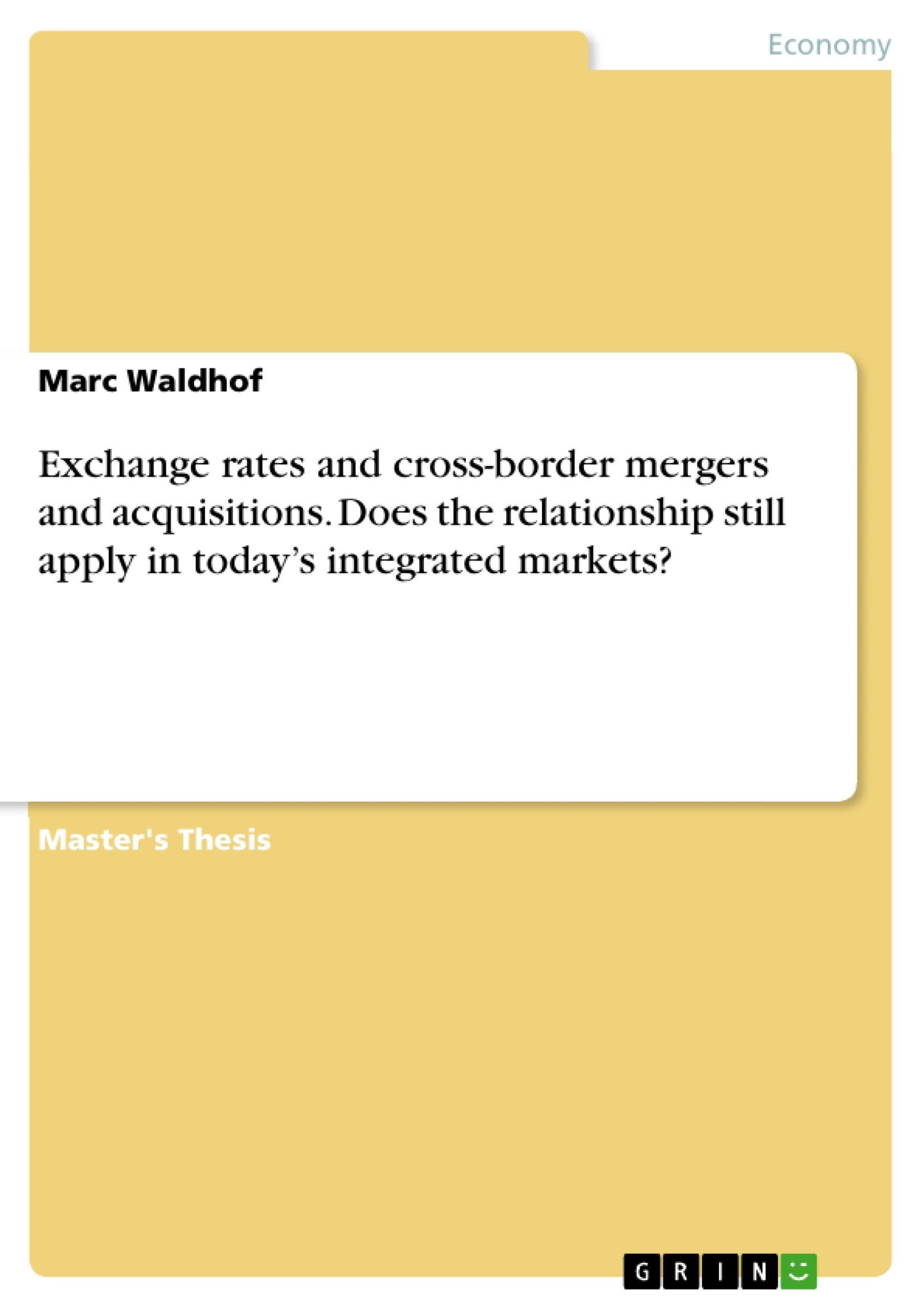The link between exchange rates and foreign direct investment is one that has caused for much discussion. Blonigen (1997) publishes one of the most influential papers and suggests transferable assets being the most important factor behind this relationship. He argues that when the real value of an acquirer’s currency increases, this acquirer will be able to purchase a foreign target cheap. Due to the nature of transferable assets, foreign acquirers will be able to generate returns from them in other currencies than the one used for the purchase. This bypasses the tradition economist’s view of purchasing power parity. One paramount condition exists in order for this link to hold: segmented markets between acquirers and targets.
We rerun Blonigen’s model to test his theory between integrated markets, as Georgopoulos (2008) suggests possible. Using industry-specific data at the three-digit NAICS 07 level, we empirically test our hypotheses with discrete dependent variable models. Testing for the link between real exchange rates and Swiss cross-border M&As in manufacturing industries in the United States and the United Kingdom for the years 1996-2013, we find no evidence for Blonigen’s firm-specific asset acquisition theory. We confirm that no relationship for low research and development manufacturing industries is evident, in line with Blonigen’s theory, whilst also no correlation is found for high research and development manufacturing industries for the studied country pairs, in the given observation period. Our findings lead us to conclude that the link between exchange rates and acquisition FDI no longer applies for integrated markets.
Moreover, we find evidence in our samples for Harris and Ravencraft’s (1991) theory that M&As in R&D-intensive industries happen more often on a cross-border basis, than on a domestic basis.
Inhaltsverzeichnis (Table of Contents)
- 1 INTRODUCTION.
- 2 SWITZERLAND
- 2.1 R&D-INTENSIVE ECONOMY.
- 2.2 EXPORT LEADERS
- 2.3 STRONG CURRENCY.
- 3 LITERATURE REVIEW
- 3.1 THE TRADITIONAL VIEW
- 3.2 THE CONTEMPORARY VIEWS.
- 3.2.1 ASYMMETRIES AND IMPERFECTIONS IN CAPITAL MARKETS
- 3.2.2 COSTS AND IMPERFECTIONS IN THE FACTOR MARKETS
- 3.2.3 COSTS AND IMPERFECTIONS IN THE GOOD MARKETS..
- 3.3 RESEARCH HYPOTHESES.
- 4 DATA AND METHODOLOGY
- 4.1 SWISS ACQUISITION FDI IN THE US AND UK – AN OVERVIEW
- 4.2 SAMPLE DESCRIPTION.
- 4.2.1 DEPENDENT VARIABLE
- 4.2.2 INDEPENDENT VARIABLES
- 4.2.3 SUMMARY OF SAMPLES
- 4.3 METHODOLOGY.
- 4.3.1 REGRESSION EQUATIONS.
- 4.3.2 POISSON MODEL
- 4.3.3 NEGATIVE BINOMINAL MODEL.
- 4.3.4 RANDOM EFFECT NEGATIVE BINOMINAL MODEL.
- 5 RESULTS..
- 5.1 DESCRIPTIVE STATISTICS.
- 5.2 EMPIRICAL RESULTS.
- 5.2.1 SWISS ACQUISITION FDI IN THE US.
- 5.2.2 SWISS ACQUISITION FDI IN THE UK
- 5.2.3 CONTROL VARIABLES
- 5.3 SUMMARY OF FINDINGS.
- 5.4 LIMITATIONS AND RECOMMENDATIONS.
- 6 CONCLUSION
Zielsetzung und Themenschwerpunkte (Objectives and Key Themes)
This dissertation investigates the relationship between exchange rates and cross-border mergers and acquisitions (M&A) in integrated markets, specifically focusing on Swiss acquisition foreign direct investment (FDI) in the United States and the United Kingdom. The study aims to re-examine the traditional view of this relationship, which posits that a stronger acquirer currency leads to cheaper acquisition targets, and assess whether this holds true in today's more integrated markets.
- The impact of exchange rates on cross-border M&A in integrated markets.
- The role of firm-specific assets and transferable assets in M&A decisions.
- The influence of research and development (R&D) intensity on cross-border M&A patterns.
- The comparison of Swiss acquisition FDI in the US and UK manufacturing industries.
- The implications of the findings for understanding cross-border M&A in a globalized economy.
Zusammenfassung der Kapitel (Chapter Summaries)
The dissertation begins with an introduction that provides an overview of the research topic, including the definition of M&A, cross-border M&A, and FDI. It also discusses the traditional view of the relationship between exchange rates and FDI, and the importance of understanding this relationship in today's globalized economy.
Chapter 2 focuses on Switzerland, providing context for the research by examining the country's economic characteristics, including its R&D-intensive economy, export leadership, and strong currency. The chapter also discusses the importance of understanding the Swiss economy in relation to cross-border M&A activity.
Chapter 3 reviews the existing literature on the relationship between exchange rates and FDI. It examines both the traditional view and contemporary perspectives, including the role of asymmetries and imperfections in capital, factor, and good markets. The chapter concludes by presenting the research hypotheses.
Chapter 4 details the data and methodology used in the study. It describes the sample of Swiss acquisition FDI in the US and UK manufacturing industries, and outlines the statistical models used to test the hypotheses. The chapter also discusses the independent and dependent variables employed in the analysis.
Chapter 5 presents the empirical results of the study, including descriptive statistics and the findings from the regression models. The chapter analyzes the relationship between exchange rates and Swiss acquisition FDI in both the US and UK markets, considering the role of R&D intensity and other control variables. It also discusses the implications of the findings for the traditional view of the exchange rate-FDI relationship.
Schlüsselwörter (Keywords)
The dissertation focuses on the relationship between exchange rates and cross-border mergers and acquisitions (M&A) in integrated markets. Key terms include foreign direct investment (FDI), firm-specific assets, transferable assets, research and development (R&D), manufacturing industries, Swiss Franc (CHF), United States Dollar (USD), Great British Pound (GBP), and discrete dependent variable models.
- Citation du texte
- Marc Waldhof (Auteur), 2014, Exchange rates and cross-border mergers and acquisitions. Does the relationship still apply in today’s integrated markets?, Munich, GRIN Verlag, https://www.grin.com/document/304013



